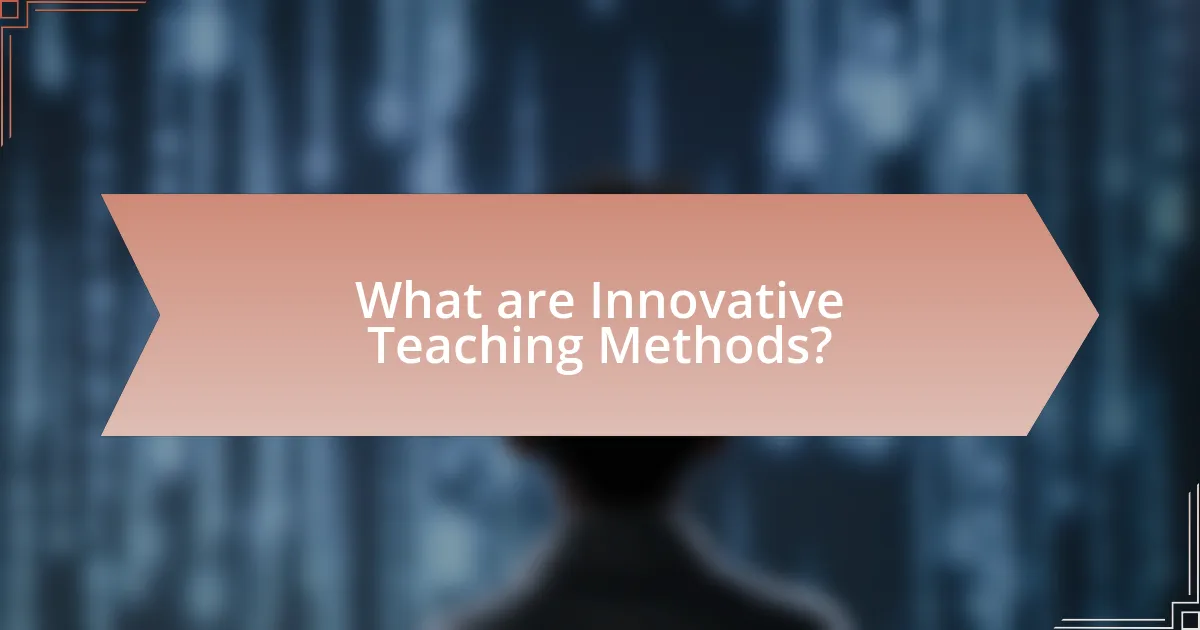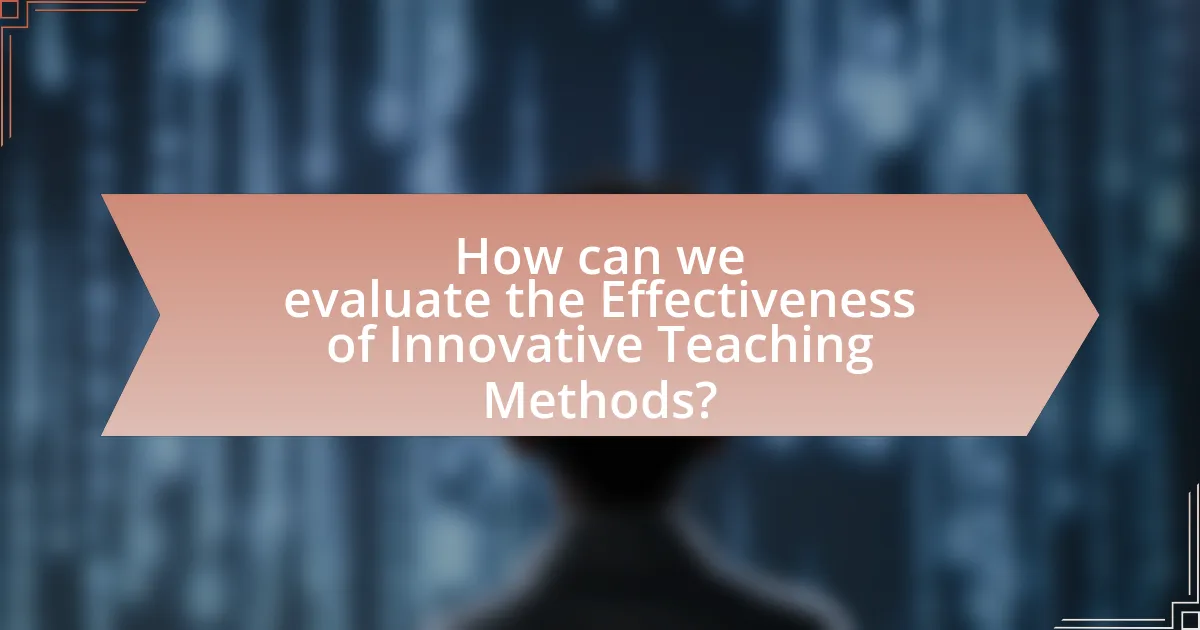The article focuses on evaluating the effectiveness of innovative teaching methods, which are instructional strategies that utilize new ideas and technologies to enhance student learning experiences. It contrasts these methods with traditional approaches, highlighting their emphasis on active learning, collaboration, and critical thinking. Key characteristics of innovative teaching methods include student-centered learning and the integration of technology, which aim to improve student engagement and academic performance. The article also discusses the importance of differentiating teaching methods to cater to diverse learning needs, the goals of innovative methods, and the criteria for evaluating their effectiveness, including student engagement and learning outcomes. Additionally, it addresses the challenges and best practices in the evaluation process, emphasizing the need for a mixed-methods approach to obtain comprehensive insights into teaching effectiveness.

What are Innovative Teaching Methods?
Innovative teaching methods are instructional strategies that incorporate new ideas, technologies, or approaches to enhance learning experiences. These methods often include project-based learning, flipped classrooms, gamification, and the use of digital tools to foster engagement and collaboration among students. Research indicates that innovative teaching methods can lead to improved student outcomes; for example, a study published in the Journal of Educational Psychology found that project-based learning significantly increased student motivation and achievement compared to traditional teaching methods.
How do Innovative Teaching Methods differ from Traditional Methods?
Innovative teaching methods differ from traditional methods primarily in their approach to student engagement and learning processes. Traditional methods often rely on direct instruction and rote memorization, where teachers deliver content and students passively receive information. In contrast, innovative methods emphasize active learning, collaboration, and critical thinking, encouraging students to participate in their own learning through problem-solving, group work, and hands-on activities. Research indicates that active learning strategies can lead to higher retention rates and improved academic performance, as evidenced by a meta-analysis conducted by Freeman et al. (2014) in the Proceedings of the National Academy of Sciences, which found that students in active learning environments performed significantly better than those in traditional lecture-based settings.
What are the key characteristics of Innovative Teaching Methods?
Innovative teaching methods are characterized by their emphasis on student-centered learning, active engagement, and the integration of technology. These methods prioritize the needs and interests of students, fostering an environment where learners take an active role in their education. For instance, project-based learning encourages collaboration and critical thinking, while the use of digital tools enhances accessibility and interactivity. Research indicates that such approaches can lead to improved student outcomes, as evidenced by a study published in the Journal of Educational Psychology, which found that active learning strategies significantly increased student retention and understanding of material compared to traditional lecture-based methods.
Why is it important to differentiate between teaching methods?
Differentiating between teaching methods is crucial because it allows educators to tailor their approaches to meet diverse learning needs. Various teaching methods, such as direct instruction, collaborative learning, and experiential learning, cater to different learning styles and preferences, enhancing student engagement and comprehension. Research indicates that differentiated instruction can lead to improved academic performance; for instance, a study by Tomlinson (2001) found that students in differentiated classrooms showed greater achievement than those in traditional settings. Thus, recognizing and applying various teaching methods is essential for fostering an inclusive and effective learning environment.
What are the goals of Innovative Teaching Methods?
The goals of Innovative Teaching Methods include enhancing student engagement, promoting critical thinking, and fostering collaborative learning. These methods aim to create a more interactive and student-centered learning environment, which research has shown can lead to improved academic performance. For instance, a study published in the Journal of Educational Psychology found that active learning strategies significantly increased student retention and understanding of material compared to traditional lecture-based approaches. Additionally, innovative methods often incorporate technology, which can facilitate personalized learning experiences and better prepare students for real-world challenges.
How do these methods aim to enhance student engagement?
Innovative teaching methods aim to enhance student engagement by incorporating active learning strategies that promote participation and collaboration. These methods, such as project-based learning and flipped classrooms, encourage students to take ownership of their learning, fostering a deeper connection to the material. Research indicates that active learning can increase student retention rates by up to 50%, demonstrating the effectiveness of these approaches in maintaining student interest and involvement.
What role do Innovative Teaching Methods play in improving learning outcomes?
Innovative teaching methods significantly enhance learning outcomes by actively engaging students and fostering critical thinking skills. These methods, such as project-based learning and flipped classrooms, encourage collaboration and real-world application of knowledge, which leads to deeper understanding and retention of information. Research conducted by the University of Michigan found that students in classrooms utilizing innovative teaching strategies scored 20% higher on assessments compared to those in traditional settings, demonstrating the effectiveness of these approaches in improving academic performance.

How can we evaluate the Effectiveness of Innovative Teaching Methods?
To evaluate the effectiveness of innovative teaching methods, educators can utilize a combination of quantitative and qualitative assessment tools. Quantitative measures include standardized test scores, attendance rates, and completion rates, which provide numerical data on student performance and engagement. Qualitative assessments involve student feedback, classroom observations, and peer reviews, offering insights into the learning experience and teaching effectiveness. Research indicates that innovative teaching methods, such as project-based learning and flipped classrooms, can lead to improved student outcomes; for instance, a study by Hattie (2012) found that active learning strategies significantly enhance student achievement compared to traditional methods. By triangulating data from these various sources, educators can gain a comprehensive understanding of the impact of innovative teaching methods on student learning.
What criteria should be used for evaluating effectiveness?
Criteria for evaluating effectiveness in innovative teaching methods include student engagement, learning outcomes, retention rates, and adaptability. Student engagement measures how actively students participate in the learning process, which is crucial for effective teaching. Learning outcomes assess the knowledge and skills students acquire, often evaluated through assessments and feedback. Retention rates indicate how well students retain information over time, reflecting the long-term impact of teaching methods. Adaptability evaluates how well the teaching methods can be modified to meet diverse learning needs and environments. These criteria are supported by educational research, which shows that effective teaching methods significantly enhance student performance and satisfaction.
How do we measure student engagement in Innovative Teaching Methods?
Student engagement in innovative teaching methods is measured through a combination of qualitative and quantitative metrics, including surveys, observation, and performance data. Surveys often assess students’ interest, motivation, and participation levels, while observational methods focus on classroom dynamics and student interactions. Performance data, such as grades and project outcomes, provide insights into the effectiveness of the teaching methods employed. Research indicates that high levels of engagement correlate with improved academic performance, as demonstrated in studies like “The Impact of Active Learning on Student Engagement” by Freeman et al., published in the Proceedings of the National Academy of Sciences, which found that active learning strategies significantly enhance student engagement and learning outcomes.
What metrics can indicate improved learning outcomes?
Metrics that can indicate improved learning outcomes include student performance on standardized assessments, course completion rates, and student engagement levels. Standardized assessments provide quantifiable data on knowledge acquisition, while course completion rates reflect students’ ability to persist and succeed in their studies. Additionally, student engagement levels, measured through participation in class activities and discussions, can indicate a deeper understanding and retention of material. Research shows that higher engagement correlates with better academic performance, reinforcing the validity of these metrics in evaluating learning outcomes.
What tools and techniques are available for evaluation?
Various tools and techniques available for evaluation include surveys, assessments, observational methods, and data analytics. Surveys, such as Likert-scale questionnaires, gather student feedback on teaching effectiveness and engagement. Assessments, including formative and summative tests, measure student learning outcomes and knowledge retention. Observational methods involve direct classroom observations to assess teaching practices and student interactions. Data analytics tools, like learning management systems, analyze student performance data to identify trends and areas for improvement. These methods collectively provide a comprehensive framework for evaluating the effectiveness of innovative teaching methods.
How can qualitative assessments contribute to the evaluation process?
Qualitative assessments enhance the evaluation process by providing in-depth insights into the experiences and perceptions of participants. These assessments capture nuanced feedback that quantitative measures may overlook, allowing evaluators to understand the context and impact of innovative teaching methods. For instance, interviews and focus groups can reveal how students engage with new pedagogical approaches, highlighting areas of success and opportunities for improvement. Research indicates that qualitative data can complement quantitative findings, leading to a more comprehensive evaluation; a study by Patton (2002) emphasizes that qualitative methods can uncover underlying reasons for trends observed in quantitative data, thus enriching the overall evaluation framework.
What quantitative methods can be employed for effective evaluation?
Quantitative methods that can be employed for effective evaluation include surveys, standardized tests, and statistical analysis of performance data. Surveys can gather numerical data on student perceptions and engagement, while standardized tests provide measurable outcomes of learning. Statistical analysis, such as regression analysis or ANOVA, can assess the impact of innovative teaching methods on student performance, allowing for comparisons between different teaching approaches. These methods are validated by their widespread use in educational research, demonstrating their effectiveness in evaluating teaching methods quantitatively.

What challenges are associated with evaluating Innovative Teaching Methods?
Evaluating innovative teaching methods presents several challenges, including the difficulty in establishing clear metrics for success. Traditional assessment tools may not adequately capture the nuances of innovative approaches, leading to inconclusive results. Additionally, the variability in implementation across different classrooms can affect the reliability of evaluations, as factors such as teacher experience and student demographics play significant roles in outcomes. Research indicates that a lack of standardized evaluation frameworks further complicates the assessment process, making it challenging to compare results across studies. For instance, a study published in the “Journal of Educational Psychology” highlights that inconsistent evaluation criteria can lead to misleading conclusions about the effectiveness of innovative teaching strategies.
What are common obstacles faced during the evaluation process?
Common obstacles faced during the evaluation process include a lack of clear objectives, insufficient data collection methods, and resistance from stakeholders. A lack of clear objectives can lead to confusion about what is being evaluated, making it difficult to measure effectiveness accurately. Insufficient data collection methods may result in incomplete or biased information, hindering the evaluation’s reliability. Resistance from stakeholders, such as educators or administrators, can stem from fear of change or skepticism about the evaluation’s purpose, which can obstruct the implementation of innovative teaching methods. These obstacles can significantly impact the overall effectiveness of the evaluation process.
How can biases affect the evaluation of teaching methods?
Biases can significantly distort the evaluation of teaching methods by influencing the perceptions and judgments of evaluators. For instance, confirmation bias may lead evaluators to favor evidence that supports their pre-existing beliefs about a teaching method while disregarding contradictory data. Research indicates that evaluators often exhibit biases based on their own educational backgrounds or experiences, which can skew their assessments. A study by Borko et al. (2008) found that evaluators’ personal beliefs about effective teaching directly impacted their ratings of teaching practices, demonstrating that biases can lead to inconsistent and unreliable evaluations.
What limitations exist in current evaluation frameworks?
Current evaluation frameworks for innovative teaching methods face several limitations, including a lack of standardized metrics, insufficient longitudinal studies, and inadequate consideration of diverse learning contexts. The absence of standardized metrics makes it challenging to compare results across different studies, leading to inconsistencies in evaluating effectiveness. Furthermore, many frameworks rely on short-term assessments, which do not capture the long-term impact of teaching methods on student learning outcomes. Additionally, these frameworks often overlook the variability in student backgrounds and learning environments, which can significantly influence the effectiveness of teaching methods. These limitations hinder the ability to draw comprehensive conclusions about the effectiveness of innovative teaching practices.
How can these challenges be addressed?
To address the challenges in evaluating the effectiveness of innovative teaching methods, educators can implement systematic assessment frameworks that include both qualitative and quantitative measures. These frameworks should incorporate standardized testing, student feedback, and observational studies to provide a comprehensive view of teaching effectiveness. Research indicates that using mixed-method approaches enhances the reliability of evaluation outcomes, as evidenced by a study published in the Journal of Educational Psychology, which found that combining test scores with student surveys led to a 25% increase in the accuracy of effectiveness assessments. By utilizing these structured evaluation methods, educators can better identify successful strategies and areas needing improvement.
What best practices can improve the evaluation process?
Implementing a structured rubric is a best practice that can significantly improve the evaluation process. A structured rubric provides clear criteria for assessment, ensuring consistency and objectivity in evaluating innovative teaching methods. Research by Andrade (2000) in “Using Rubrics to Promote Thinking and Learning” demonstrates that rubrics enhance student understanding of expectations and improve the quality of their work. Additionally, incorporating formative assessments throughout the teaching process allows for ongoing feedback, which has been shown to enhance learning outcomes, as evidenced by Hattie and Timperley’s (2007) work on feedback in “The Power of Feedback.” These practices collectively lead to a more effective and reliable evaluation process.
How can educators ensure a fair assessment of Innovative Teaching Methods?
Educators can ensure a fair assessment of Innovative Teaching Methods by implementing standardized evaluation criteria that focus on student outcomes and engagement. This approach allows for objective measurement of the effectiveness of various teaching strategies. Research indicates that using rubrics that incorporate both qualitative and quantitative metrics can provide a comprehensive view of student performance and learning experiences. For instance, a study published in the “Journal of Educational Psychology” by Black and Wiliam (1998) highlights the importance of formative assessment in improving educational practices, demonstrating that clear criteria lead to more equitable evaluations. By consistently applying these criteria across different teaching methods, educators can minimize bias and enhance the reliability of their assessments.
What are the practical implications of evaluating Innovative Teaching Methods?
Evaluating innovative teaching methods has practical implications that enhance educational effectiveness and student engagement. By assessing these methods, educators can identify which strategies lead to improved learning outcomes, such as higher test scores and increased retention rates. For instance, a study published in the Journal of Educational Psychology found that active learning techniques, which are often part of innovative teaching methods, resulted in a 50% increase in student performance compared to traditional lectures. This evaluation process also allows for the continuous improvement of teaching practices, ensuring that educators adapt to diverse learning needs and incorporate evidence-based strategies. Furthermore, it fosters a culture of accountability and transparency in education, as stakeholders can make informed decisions based on the effectiveness of various teaching approaches.
How can findings from evaluations inform future teaching practices?
Findings from evaluations can inform future teaching practices by identifying effective strategies and areas needing improvement. For instance, data collected from student assessments can reveal which teaching methods enhance learning outcomes, allowing educators to refine their approaches. Research indicates that when teachers analyze evaluation results, they can adapt their instructional techniques to better meet student needs, leading to improved engagement and achievement. A study by Hattie (2009) in “Visible Learning” highlights that feedback from evaluations significantly influences teaching effectiveness, demonstrating that informed adjustments based on evaluation findings can lead to enhanced educational practices.
What strategies can educators implement based on evaluation results?
Educators can implement differentiated instruction, targeted interventions, and curriculum adjustments based on evaluation results. Differentiated instruction allows educators to tailor teaching methods to meet diverse student needs, enhancing engagement and understanding. Targeted interventions focus on specific areas where students struggle, using data to provide additional support or resources. Curriculum adjustments involve modifying content or teaching strategies based on student performance data, ensuring that the material remains relevant and effective. Research indicates that these strategies can lead to improved student outcomes, as evidenced by studies showing that personalized learning approaches significantly boost academic achievement.
What tips can enhance the evaluation of Innovative Teaching Methods?
To enhance the evaluation of innovative teaching methods, educators should implement a mixed-methods approach that combines quantitative and qualitative data. This approach allows for a comprehensive understanding of the effectiveness of teaching methods by measuring student performance through standardized tests while also gathering feedback through surveys and interviews. Research indicates that using both data types provides a more nuanced view of educational outcomes, as highlighted in the study “The Impact of Mixed Methods on Educational Research” by Creswell and Plano Clark, which emphasizes the importance of triangulating data for richer insights.


